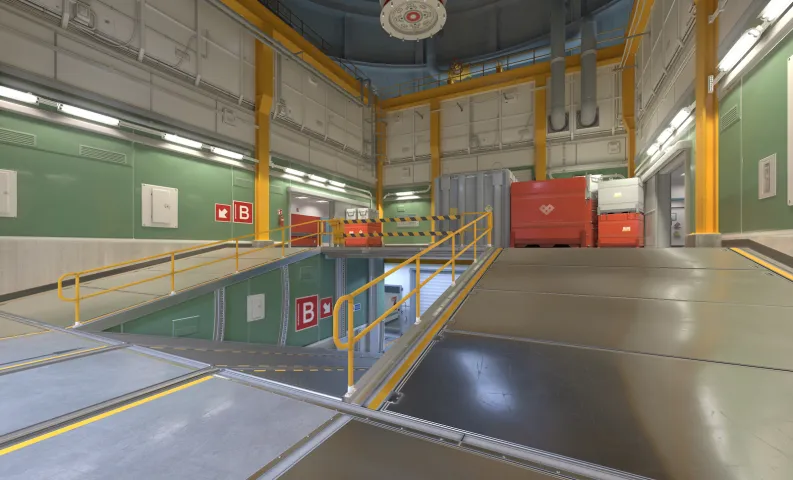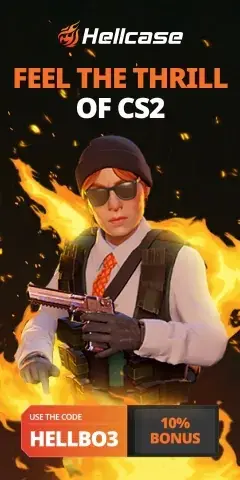
Nuke
Covering the Nuke map in the world of Counter-Strike
The Nuke map, also known as de_nuke, is one of the most unique and recognizable maps in the Counter-Strike series of games, including Counter-Strike, Counter-Strike: Source, Counter-Strike: Global Offensive and Counter-Strike 2. This map is for the mode Bomb Defusal holds a special place in the hearts of players due to its unconventional structure and rich development history.
Origins and Evolution
Originally introduced in Counter-Strike, Nuke revolves around the theme of a nuclear threat, where one team (the Terrorists) seeks to blow up a nuclear facility while the other (the Counter-Terrorists) tries to prevent disaster. The scenario takes place against the backdrop of an industrial area, which in different versions of the game is described as a German or American nuclear power plant.
Unlike most Counter-Strike maps, which emphasize multiple paths and corridors, Nuke is built around a central structure with two bomb sites stacked on top of each other. This feature makes the map especially interesting for strategic play and team coordination.
The first mention of the Nuke map occurred in Counter-Strike Beta 4.0. But the latter is now in the active Mappool of Counter-Strike 2. Moreover, both in the competitive mode and also in the Partner mode. But overall, Nuke was present in the following versions of the game:
- Counter-Strike Beta
- Counter-Strike
- Counter-Strike: Condition Zero
- Counter-Strike: Source
- Counter-Strike: Global Offensive
- Operation Wildfire
- Counter-Strike 2
The following studios and individuals contributed their efforts to developing the map:
- Jo Bieg
- Turtle Rock Studios
- Hidden Path Entertainment
- Valve Corporation

Features of the Map
The official description of the map in different versions of the game highlights the variety of tactics and strategies available to both Terrorists and Counter-Terrorists. In Counter-Strike, Terrorists aim to destroy a nuclear reactor, while in Global Offensive and CS2, the scenarios go deeper, offering more complex challenges and objectives.
The Global Offensive and CS2 versions of the map bring significant changes not only to the design, but also to the gameplay, including adapting textures, lighting and map structure to create a more realistic and immersive atmosphere.
In CS:GO, the Nuke map went through several revisions, including a large-scale redesign that added new mechanics and changes to the location of key points, making the map more balanced for competitive play.

But with the arrival of CS2, the lighting and textures on the map were changed. It was after the release of Counter-Strike 2 that the Nuke map lost the same ambience of games on Source. Just if you go to Nuke in CS:GO alone. This emptiness will weigh on you. The sounds of the environment further intensify the atmosphere, and we are not yet saying that the game was gray and gloomier.
While in CS2 everything is light and colorful. And the same ambiance from other Valve games is not created at all.
Implications for the Community
Nuke has earned the love and respect of players for its story, complexity, and ability to showcase both team and individual skills. The map has been the scene of many memorable moments in CS:GO competitions, becoming an integral part of the Counter-Strike culture.
Each version of the Nuke map bears the imprint of its time, demonstrating the evolution of map design and gameplay mechanics in the Counter-Strike series. From simple beginnings to the complex and detailed scenarios of CS2, Nuke remains one of the most significant and talked about maps in the history of the game.
Interesting Facts about the Nuke Map in Counter-Strike
The Nuke map is one of the most iconic and talked about in the Counter-Strike series, and like any other legendary map, it has many unique features and interesting details.
Counter-Strike up to version 1.6
- Before version 1.6, the box in the basement near the bomb site B could be destroyed with a weapon. In version 1.6 this box became indestructible.
- On the map you can find the HECU radio props from Half-Life.
Counter-Strike: Source
- There are three fire extinguishers scattered around the map. If they are shot at, they will emit a gas that can be used for camouflage, similar to a smoke grenade.
- If C4 successfully detonates at any of the planting sites, an alarm will sound.
- In Counter-Strike: Source, the radar is displayed in green, similar to the color of night vision.
- The truck near the terrorist spawn area and the car in the background have California license plates with "DE_NUKE" written on them. This could also be seen in the original version of Global Offensive.
- Near the terrorist spawn area, you can find a payment kiosk with a bloody corpse of a guard. This is also present in the original version of Global Offensive.
- In Global Offensive, the guard's face is reused from the "male 07" citizen face model in Half-Life 2.
- The name of the nuclear power plant is MAC Nuclear Power Plant.
- The map has hidden red letters "MAC Man", which is a reference to Chris Ashton, also known as MacMan.

Global Offensive
- The nuclear storage containers located at both bomb sites would not actually be able to fit through the gate of the hangar they are in.
- The map was presented in the Counter-Strike: Global Offensive trailer.
- In the trailer, the terrorists were Phoenix Connexion, and the counter-terrorists were GSG-9. Before the map rework, the terrorists and counter-terrorists were always the Balkans and the SAS, respectively.
- According to the trailer, Nuke is located in Harz, Germany at approximately 17:25 (GMT+1).
- The map is located in Harz, Germany. This is confirmed by elements of the map in the game, where the name of the nuclear power plant is "Harz Kernkraftwerk" (Harz Nuclear Power Plant) and the management company is "Harz Energiewerk Süd GmbH" (South Harz Energy Company GmbH).
- "Kernkraftwerk Harz" can also be seen on the original Nuke collection badge.
- According to posters located throughout the plant, Harz Kernkraftwerk was to begin the decommissioning process between 1993 and 2010: removal of nuclear fuel and waste was to begin from 1993, then dismantling of areas outside the control room from 1997, dismantling of the control room and reactor with 1998 and then demolition of the plant by 2010.
- A hidden plaque can be found on top of the ramp crane commemorating the map's original creator, Yo Big, and Turtle Rock Studios' work on the Source version that Global Offensive inherited.

Counter-Strike 2
As we said earlier, no geometric or other changes were made to the map.
These interesting facts highlight the depth and complexity that the developers put into creating Counter-Strike maps, making each one unique and memorable.

Article info
Wiki
Latest top news




![[Exclusive] James Banks on the best transfer of 2025: “molodoy to FURIA”](https://image-proxy.bo3.gg/uploads/news/375221/title_image_square/webp-cb1c4993aeb1c0987edad3f90713e0dc.webp.webp?w=60&h=60)
![[Exclusive] ZywOo: “Back-to-back Majors in the same year is something very special”](https://image-proxy.bo3.gg/uploads/news/375190/title_image_square/webp-212a61c0913d3def63054f4806f6dad3.webp.webp?w=60&h=60)
